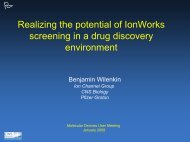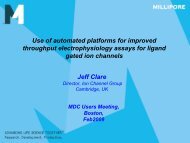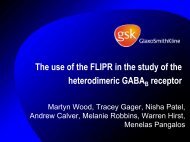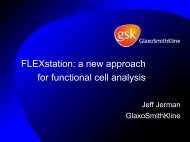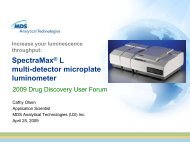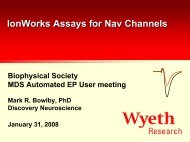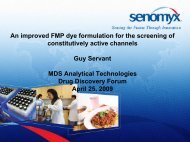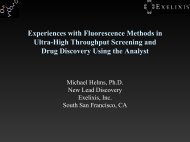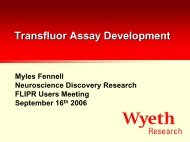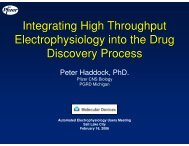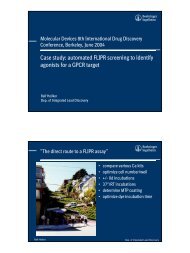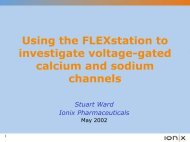Biomarkers of High Grade Dysplasia in Barrett's Esophagus
Biomarkers of High Grade Dysplasia in Barrett's Esophagus
Biomarkers of High Grade Dysplasia in Barrett's Esophagus
You also want an ePaper? Increase the reach of your titles
YUMPU automatically turns print PDFs into web optimized ePapers that Google loves.
<strong>Biomarkers</strong> <strong>of</strong> <strong>High</strong> <strong>Grade</strong><strong>Dysplasia</strong> <strong>in</strong> Barrett’s<strong>Esophagus</strong>Murray Resnick, MD/PhDDirector <strong>of</strong> Surgical Pathologyand Co-Director <strong>of</strong> the Molecular PathologyCore Facility, Rhode Island Hospital andAlpert Medical School <strong>of</strong> Brown University
Barrett’s <strong>Esophagus</strong> Def<strong>in</strong>itionA premalignant condition <strong>in</strong> which the normal squamousepithelium <strong>of</strong> the distal esophagus undergoes metaplasiato a specialized <strong>in</strong>test<strong>in</strong>al epithelium.
Barrett’s <strong>Esophagus</strong>• 5-15% <strong>of</strong> all patients with reflux esophagitis(up to 20% <strong>of</strong> population have GERD)• For every patient with BE another 20 go undetected(Olmstead County autopsy study)• Much more common <strong>in</strong> white males even <strong>in</strong> populationswith high <strong>in</strong>cidence <strong>of</strong> reflux
BE Pathogenesis• Reflux <strong>in</strong>duces <strong>in</strong>flammation and mucosal <strong>in</strong>jury• Heal<strong>in</strong>g occurs by <strong>in</strong>-growth <strong>of</strong> stem cells andre-epitheliazation•Cells differentiate <strong>in</strong>to <strong>in</strong>test<strong>in</strong>al mucosa may<strong>of</strong>fer more resistance to acid damage
Barrett’s <strong>Esophagus</strong> SequelaeUlcerationBleed<strong>in</strong>gStricture<strong>Dysplasia</strong> Adenocarc<strong>in</strong>oma
BE and Adenocarc<strong>in</strong>omaOnly patients with specialized columnar epithelium are atrisk for develop<strong>in</strong>g Barrett’s related EAC.EAC develop <strong>in</strong> BE at the rate <strong>of</strong> 1 cancer per 125yrpatient follow-up (annual <strong>in</strong>cidence rate <strong>of</strong> 800/100,000)Increased frequency <strong>in</strong> EAC <strong>in</strong> white malesobserved <strong>in</strong> last 20yrs (<strong>in</strong>creases 5-10% per year)Why is EAC <strong>in</strong>creas<strong>in</strong>g?Older populationObesityDecrease <strong>in</strong> helicobacter <strong>in</strong>fection
Histopathologic Dx <strong>of</strong> <strong>Dysplasia</strong><strong>Dysplasia</strong>: Presence <strong>of</strong> neoplastic epithelium thatrema<strong>in</strong>s conf<strong>in</strong>ed with<strong>in</strong> the basement membrane.Occurs <strong>in</strong> up to 10-20% <strong>of</strong> cases if left untreated.Identification <strong>of</strong> dysplasia by light microscopy isstill considered the “gold standard” by which patientfollow-up and treatment is coord<strong>in</strong>ated.
Significance <strong>of</strong> <strong>Dysplasia</strong> <strong>in</strong> BE<strong>Dysplasia</strong> <strong>in</strong> BE:Presence <strong>of</strong> dysplasia (particularly HGD) is a risk factorfor synchronous and metachronous EAC.<strong>Dysplasia</strong> is frequently seen adjacent to and distant fromBarrett’s related EAC.<strong>Dysplasia</strong> is both a marker <strong>of</strong> adenocarc<strong>in</strong>oma and isclearly the pre-<strong>in</strong>vasive lesion.
<strong>Dysplasia</strong> <strong>in</strong> Barrett’s <strong>Esophagus</strong>•Negative for dysplasia•Positive for dysplasiaLow grade dysplasia<strong>High</strong> grade dysplasia•Indef<strong>in</strong>ite for dysplasia
Grad<strong>in</strong>g <strong>Dysplasia</strong> <strong>in</strong> BEFeature Negative IND LGD HGDSurface + + - -maturationArchitecture Normal Normal or mild Mild alteration Marked alterationalterationCytology Normal or Mild alterations or Mild alterations (D) Marked alteration;reactive focal marked with or marked (F); loss <strong>of</strong> polarity<strong>in</strong>flammation ma<strong>in</strong>ta<strong>in</strong>ed polarity(Montgomery et al Human Pathology 2001)
LGD
Surveillance Guidel<strong>in</strong>esInitial screen<strong>in</strong>g <strong>of</strong> <strong>in</strong>dividuals with highest risk:white men over 50 with chronic symptoms <strong>of</strong> heartburnNo dysplasia- Every 2-3yrs after two negative endoscopiesLGD - Every 6mths for 1yr, then yearlyHGD- Second confirmation followed by surgery orevery 3mth surveillanceSurveillance = 4 quarter biopsies at 2cm <strong>in</strong>tervals
<strong>Dysplasia</strong> <strong>in</strong> BEPitfalls• Sampl<strong>in</strong>g errors• Diagnostic <strong>in</strong>terpretationreactive vs dysplasticlow-grade vs high gradehigh grade vs <strong>in</strong>tramucosal ca
Barrett’s Related <strong>Dysplasia</strong>Interobserver AgreementCategory%AgreementHGD+IMC vs others 85-87%Negative vs others 71-72%Negative+Ind vs others 75-77%Neg vs <strong>in</strong>d/LG vs HGD/IMC 58-61%Reid BJ et al Human Pathology 1988
Ancillary Techniques <strong>in</strong> theScreen<strong>in</strong>g and DX <strong>of</strong> BEFlow cytometry Aneuploidy more common <strong>in</strong> HGD and maybe a marker for progressionMolecular P53 (late)Cycl<strong>in</strong> D1 expression (early)Telomerase (early and non-dysplastic)p16 hypermethylation or mutation (early)Brush cytology and balloon cytology“Light” biopsy (fluorescence, optical coherence tomography)
ObjectivesIdentify differentially expressed genes <strong>in</strong> HGD compared withnon-dysplastic Barrett’s esophagus through gene microarrayanalysis <strong>of</strong> epithelial cells microdissected from archival tissuespecimens by LCM.Identify markers <strong>of</strong> dysplasia suitable for immunohistochemistry
Advantages over other microarray studies screen<strong>in</strong>g forbiomarkers <strong>of</strong> BE associated dysplasia:LCM <strong>of</strong> epithelium as opposed to whole biopsies allows for:Identification <strong>of</strong> epithelial associated genes.Confirms by direct visualization presence <strong>of</strong> dysplasia.Only study to use formal<strong>in</strong>-fixed paraff<strong>in</strong> embedded archivaltissues.One <strong>of</strong> only two studies to use samples <strong>of</strong> dysplasia and nondysplasticBE from the same patient (other n=1).
Methods (1)• Esophageal biopsies (11 cases)– Formal<strong>in</strong>-fixed, paraff<strong>in</strong>-embedded. 2004-7– Inclusion criteria• Good tissue orientation• Easily def<strong>in</strong>ed areas <strong>of</strong> HGD and normal BE (SAME PATIENT!!)• HGD confirmed by 2-3 GI pathologists• Must have high quality mRNA–10μm sections deparaff<strong>in</strong>ized, scraped– RNA extracted with Paradise kit (Arcturus)– DNA removed (DNAse)– RNA quality determ<strong>in</strong>ed by» Agilent 2100 Bioanalyser» 5’ and 3’ β-act<strong>in</strong> RT-PCR (oligo-dT)–3’:5’β -act<strong>in</strong> < 10; >15ng
Specimen Evaluation40 cases (1-6 blocks <strong>of</strong> biopsies per case) received fromcollaborators26 had both NBE and HGD available for LCM11 had sufficient quantities <strong>of</strong> RNA and passed 3’5’ QCevaluation for <strong>in</strong>tact RNA
Methods (2)• RNA Extraction/Preparation– 2500 surface esophageal epithelial cells (AutoPix LCM)– RNA extracted (Paradise kit, Arcturus)– RNA quality determ<strong>in</strong>ed by 5’ and 3’ β-act<strong>in</strong> QT-PCR– Amplified and Reverse transcribed (Arcturus T7 kit)– cDNA → biot<strong>in</strong>-labeled cRNA labeled (Enzo kit)– Chip hybridization, sta<strong>in</strong><strong>in</strong>g with streptavid<strong>in</strong> bound tophycoerytr<strong>in</strong>, expression assayed (Keck Center, Yale)– Affymetrix custom U133-X3P expression array• As for standard U133+2 array– 61,000 probe sets target<strong>in</strong>g 47,000 transcripts• But, focused on 300 bases at 3’ end– Because FFPE mRNA fragmentation, chemical modification, esp 5’
Biopsy <strong>of</strong> Normal BE
Biopsy <strong>of</strong> HGD
Use <strong>of</strong> Aperio ScanScope for Remote Onl<strong>in</strong>e Annotation<strong>of</strong> Slides for LCMAperioScanScopeCS SystemEntire slide scanned <strong>in</strong> labAccessed by <strong>in</strong>ternet l<strong>in</strong>k from pathologist’s <strong>of</strong>ficeSmall biopsies with m<strong>in</strong>or areas <strong>of</strong> specific cellsidentified and annotated with pathologist’s expertiseAnnotated image displayed on Autopix screenLab tech uses as reference to guide dissectionLaser Micro Dissection
Laser Capture MicrodissectionBarrett’s Epithelium<strong>High</strong> <strong>Grade</strong> <strong>Dysplasia</strong>ABABCDCDEsophageal epithelium sta<strong>in</strong>ed with Histogene sta<strong>in</strong><strong>in</strong>g solution (A), marked for capture (B),after capture (C) and captured cells after dissection (D)
Bio<strong>in</strong>formaticsExpression signals normalized us<strong>in</strong>g the Standardization andNormalization <strong>of</strong> Microarray Data web-based s<strong>of</strong>twareConcordant absent expression signals were removed from analysisStatistical comparison <strong>of</strong> HGD to ND was done us<strong>in</strong>g the Wilcoxonmatched-pairs signal ranks test (>2.5 fold cut<strong>of</strong>f, p
Results132 genes with 2.5 > <strong>in</strong>creased expression <strong>in</strong> HGD vs ND BE13 genes with 2.5 > decreased expression <strong>in</strong> HGD vs ND BE
Dysregulated Genes <strong>in</strong> HGD by Functional CategorySignal TransductionCell Communication and MotilityImmune ResponseECM and ProteaseProte<strong>in</strong> B<strong>in</strong>d<strong>in</strong>gCalcium B<strong>in</strong>d<strong>in</strong>g and Ion ChannelMiscellaneousCell Adhesion and MembraneCell Proliferation and Cell DeathStructural and CytoskeletonMetabolism and MitochondriaNucleic Acid B<strong>in</strong>d<strong>in</strong>g &Transcription Factors-10 -5 0 5 10 15 20 25Down-regulated <strong>in</strong> HGD Up-regulated <strong>in</strong> HGD
Table 2. Differentially Expressed Genes Confirmed by Real-Time Quantitative PCR*GeneChipFunctional Gene Group GeneBank ID Fold p valueChangeUpregulated genesComplement component 3 Miscellaneous NM_000064 13.1 0.016Topoisomerase (DNA) IIα 170kDa Cell proliferation and cell death AL561834 12.6 0.01Matrix metallopeptidase 1 (<strong>in</strong>terstitial collagenase) Extracellular matrix and protease NM_002421 10.8 0.018Matrix metallopeptidase 12 (macrophage elastase) Extracellular matrix and protease NM_002426 9.3 0.006TIA1 cytotoxic granule-associated RNA b<strong>in</strong>d<strong>in</strong>g prote<strong>in</strong>-like 1 Cell proliferation and cell death NM_003252 8.3 0.005Prote<strong>in</strong> tyros<strong>in</strong>e phosphatase, non-receptor type 7 Metabolism and mitochondria NM_002832 7.3 0.010Nurim (nuclear envelope membrane prote<strong>in</strong>) Cell adhesion, motility and membrane prote<strong>in</strong>s NM_014641 7 0.016Histone cluster 1, H2ag Nucleic acid b<strong>in</strong>d<strong>in</strong>g and transcription factors NM_021064 7 0.004Lipocal<strong>in</strong>-2 (oncogene 24p3) Ca+ b<strong>in</strong>d<strong>in</strong>g and ion channels NM_005564 6.8 0.003Fidget<strong>in</strong>-like 1 Cell proliferation and cell death AK023411 6.8 0.01Prote<strong>in</strong> phosphatase 2 (formerly 2A), catalytic subunit, β is<strong>of</strong>orm Cell proliferation and cell death AI379894 6.7 0.003Formyl peptide receptor 1 Cell adhesion, motility and membrane prote<strong>in</strong>s NM_002029 6.40.003M<strong>in</strong>ichromosome ma<strong>in</strong>tenance complex component 10 Cell proliferation and cell death AL136840 6.3 0.005Secern<strong>in</strong> 1 Miscellaneous NM_014766 6 0.004S100 calcium b<strong>in</strong>d<strong>in</strong>g prote<strong>in</strong> A9 Ca+ b<strong>in</strong>d<strong>in</strong>g and ion channels NM_002965 4.1 0.003Downregulated genesFatty acid b<strong>in</strong>d<strong>in</strong>g prote<strong>in</strong> 1 liver Metabolism and mitochondria NM_001443 -2.5 0.003Trefoil factor 1 Cell adhesion, motility and membrane prote<strong>in</strong>s NM_003225 -2.6 0.003Muc<strong>in</strong> 5AC, oligomeric mucus/gel-form<strong>in</strong>g Extracellular matrix and protease AW192795 -2.6 0.01Aldolase B, fructose-bisphosphate Metabolism and mitochondria NM_000035 -2.8 0.003Calcium/calmodul<strong>in</strong>-dependent prote<strong>in</strong> k<strong>in</strong>ase II <strong>in</strong>hibitor 1 Signal transduction N75559 -3 0.006Hydroxysteroid (17-β) dehydrogenase 2 Metabolism and mitochondria NM_002153 -3.1 0.003Hydroxyprostagland<strong>in</strong> dehydrogenase 15-(NAD) Metabolism and mitochondria J05594 -3.3 0.004Mepr<strong>in</strong> A, alpha (PABA peptide hydrolase) Extracellular matrix and protease NM_005588 -4.7 0.003Alanyl (membrane) am<strong>in</strong>opeptidase Extracellular matrix and protease NM_001150 -4.7 0.003
CAMK2N1MUC5ACHSD17BPGDHAMEP1AALDOBANPEPFABP1TFF1HIST2H2AA3FPR1MMP12FIGNLMCM10LCN2HIST1H2AGPTPN7TIALPPP2CBSCRN1NRMS100A9TOP2A151050Fold Change-5-10-15Confirmation <strong>of</strong> the Expression Levels <strong>of</strong> SelectedDysregulated Genes by real-time PCR andCorrelation with Microarray DataR S = 0.75, p
Prote<strong>in</strong> Expression Confirmed by ImmunohistochemistryUpregulatedTopoisomerase II alpha•DNA replication <strong>in</strong> a number <strong>of</strong> cancersLipocal<strong>in</strong>-2•Cell survival factor upregulated <strong>in</strong> GI cancersS100-A9•Chemotaxis and cell proliferationDownregulatedTrefoil Factor –1•Putative tumor suppressor gene <strong>in</strong> GI cancers
Topoisomerase II alpha
Lipocal<strong>in</strong>-2
S100-A9
Trefoil factor 1
Immunohistochemical sta<strong>in</strong>s for topoisomerase IIa (Topo), lipocal<strong>in</strong>-2 (Lipo),S100A9 (S-100), and TFF1. ADCA, adenocarc<strong>in</strong>omaTopoNumber <strong>of</strong> cases15105012(100%)p < 0.01 for:NDBE vs AllLGD vs HGD075 6(58%) 5 4(45%)(55%)(42%) (33%)0 0 0(8%)1NDBE LGD HGD ADCA7(58%)Number <strong>of</strong> casesLipo12108642011(92%)p < 0.02 for:NDBE vs All21(18%)(8%)05(46%) 4(36%)5(42%)5(42%)2(16%)7(58%)5(42%)NDBE LGD HGD ADCA0Number <strong>of</strong> casesS-10012108642012(100%)0 0p < 0.03 for:NDBE vs AllHGD vs ADCA7(64%)4(36%)07(58%)5(42%)01(8%)NDBE LGD HGD ADCA6(50%) 5(42%)Number <strong>of</strong> casesTFF1IHC Score = +1 IHC Score = +2 IHC Score = +31210864200 012(100%)4(36%)p < 0.03 for:NDBE vs AllLGD vs HGD9(82%)1(9%)6(55%)1 1(9%) (9%)11(92%)01(8%)NDBE LGD HGD ADCA
Next Steps……1. Cont<strong>in</strong>ue test<strong>in</strong>g different commercially available markers2. Generate Abs towards novel prote<strong>in</strong>s3. Determ<strong>in</strong>e utility <strong>of</strong> the expression <strong>of</strong> these markers on a large group<strong>of</strong> BE associated dysplasia cases.a. LGD vs HGDb. Indef<strong>in</strong>ite vs LGD (or HGD)4. Determ<strong>in</strong>e whether these markers can predict progression from LGDor HGD to adenocarc<strong>in</strong>oma.
Thanks to…….Patricia A. MeitnerEdmond SaboRosemarie TavaresSteven F.MossCOBRE Core lab Rhode Island HospitalPathology, Rambam Medical CenterHaifa, IsraelCOBRE Core lab Rhode Island HospitalGI/Medic<strong>in</strong>e, Brown University, ProvidenceChristopher L. Corless Pathology, OHSU Portland OregonGregory Y. LauwersPathology, Mass General HospitalSupported <strong>in</strong> part by the Rhode Island Hospital COBRE CCRD.Director: Douglas C. Hixson, PhD
Molecular Pathology CoreRonald DeLellis, MDMurray Resnick, MD/PhDPatricia Meitner, PhDRose TavaresLelia NobleLaura GanttAldrich Build<strong>in</strong>g, 6 th FloorRhode Island HospitalStaffCore DirectorCore Co-Director, Tissue BankMolecular Biology & LCMIHC and TMAsTissue Bank and TMAsAdm<strong>in</strong>istrative/Bill<strong>in</strong>gSupported <strong>in</strong> part by the Rhode Island Hospital COBRE CCRD. Director: Douglas C. Hixson, PhD



